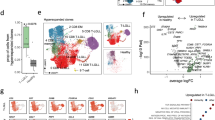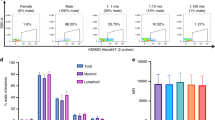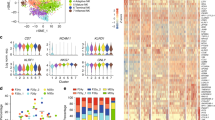Abstract
The killer cell Ig-like receptor (KIR) expression repertoire may offer valuable information for hematopoietic SCT (HSCT). We designed a quantitative KIR RNAtype assay and used it to determine KIR gene expression in healthy donors and patients before HSCT. The specificity of the assay was ensured by specific primers and by electrophoretic distinction of PCR products of unique length. In 87 healthy donors, the KIR repertoire was broadly distributed (32 categories of profiles). There was an overall trend toward inverse correlation of KIR expression level and donor age. Age affected mainly the activating KIR families. Leukemia patients showed lower KIR expression before transplantation than healthy donors. Stem cell mobilization caused a transient increase of KIR expression. We conclude that KIR expression differs quantitatively with age and primary disease and is transiently altered by stem cell recruitment and selection.
This is a preview of subscription content, access via your institution
Access options
Subscribe to this journal
Receive 12 print issues and online access
$259.00 per year
only $21.58 per issue
Buy this article
- Purchase on Springer Link
- Instant access to full article PDF
Prices may be subject to local taxes which are calculated during checkout





Similar content being viewed by others
References
Carrington M, Martin MP . The impact of variation at the KIR gene cluster on human disease. Curr Top Microbiol Immunol 2006; 298: 225–257.
Vilches C, Parham P . KIR: diverse, rapidly evolving receptors of innate and adaptive immunity. Annu Rev Immunol 2002; 20: 217–251.
Borrego F, Kabat J, Kim DK, Lieto L, Maasho K, Pena J et al. Structure and function of major histocompatibility complex (MHC) class I specific receptors expressed on human natural killer (NK) cells. Mol Immunol 2002; 38: 637–660.
Ruggeri L, Capanni M, Mancusi A, Martelli MF, Velardi A . The impact of donor natural killer cell alloreactivity on allogeneic hematopoietic transplantation. Transpl Immunol 2005; 14: 203–206.
Koenecke C, Shaffer J, Alexander SI, Preffer F, Dombkowski D, Saidman SL et al. NK cell recovery, chimerism, function, and recognition in recipients of haploidentical hematopoietic cell transplantation following nonmyeloablative conditioning using a humanized anti-CE2mAB, Medi-507. Exp Hematol 2003; 31: 911–923.
Gagne K, Brizard G, Gueglio B, Milpied N, Herry P, Bonneville F et al. Relevance of KIR gene polymorphisms in bone marrow transplantation outcome. Hum Immunol 2002; 63: 271–280.
Bignon JD, Gagne K . KIR matching in hematopoietic stem cell transplantation. Curr Opin Immunol 2005; 17: 553–559.
Dupont B, Hsu KC . Inhibitory killer Ig-like receptor genes and human leukocyte antigen class I ligands in hematopoietic stem cell transplantation. Curr Opin Immunol 2004; 16: 634–643.
Leung W, Iyengar R, Turner V, Lang P, Bader P, Conn P et al. Determinants of antileukemia effects of allogeneic NK cells. J Immunol 2004; 172: 644–650.
Hsu KC, Keever-Taylor CA, Wilton A, Pinto C, Heller G, Arkun K et al. Improved outcome in HLA-identical sibling hematopoietic stem-cell transplantation for acute myelogenous leukemia predicted by KIR and HLA genotypes. Blood 2005; 105: 4878–4884.
Keller MD, Chen DF, Condron SA, Liu N, Reinsmoen NL, Buckley RH . The effect of natural killer cell killer Ig-like receptor alloreactivity on the outcome of bone marrow stem cell transplantation for severe combined immunodeficiency. J Clin Immunol 2007; 27: 109–116.
Leung W, Iyengar R, Triplett B, Turner V, Behm FG, Holladay MS et al. Comparison of killer Ig-like receptor genotyping and phenotyping for selection of allogeneic blood stem cell donors. J Immunol 2005; 174: 6540–6545.
Shilling HG, McQueen KL, Cheng NW, Shizuru JA, Negrin RS, Parham P . Reconstitution of NK cell receptor repertoire following HLA-matched hematopoietic cell transplantation. Blood 2003; 101: 3730–3740.
Denis L, Gagne K, Gueglio B, Kendudou N, Milpies N, Simon P et al. NK-KIR transcript kinetics correlate with acute graft-versus-host disease occurrence after allogeneic bone marrow transplantation. Hum Immunol 2005; 66: 447–459.
Benjamini Y, Hochberg Y . Controlling the false discovery rate: a practical and powerful approach to multiple testing. J Roy Stat Soc 1995; 57: 289–300.
Garcia CA, Robinson J, Guethlein LA, Parham P, Madrigal JA, Marsh SG . Human KIR sequences 2003. Immunogenetics 2003; 55: 227–239.
Cooper MA, Fehniger TA, Caligiuri MA . The biology of human natural killer-cell subsets. Trend Immunol 2001; 22: 633–640.
Acknowledgements
We thank all scientists, physicians and nurses in the Division of Bone Marrow Transplantation and Cellular Therapy for their contribution to this study. We thank Dr T Leimig, Dr R Iyengar, and A Kennedy for help in collecting samples, Martha S Holladay and Barbara Rooney, for help with the Flow Cytometry assay, J Okuma in the Department of Biostatistics for statistical analysis, Dr V Turner for her kindly writing up suggestions, and Dr P Rodrigues in the Hartwell Center for making the primers. We thank S Naron for editorial assistance.
Author information
Authors and Affiliations
Corresponding author
Rights and permissions
About this article
Cite this article
Chen, X., Knowles, J., Barfield, R. et al. A novel approach for quantification of KIR expression in healthy donors and pediatric recipients of hematopoietic SCTs. Bone Marrow Transplant 43, 525–532 (2009). https://doi.org/10.1038/bmt.2008.352
Received:
Revised:
Accepted:
Published:
Issue Date:
DOI: https://doi.org/10.1038/bmt.2008.352



